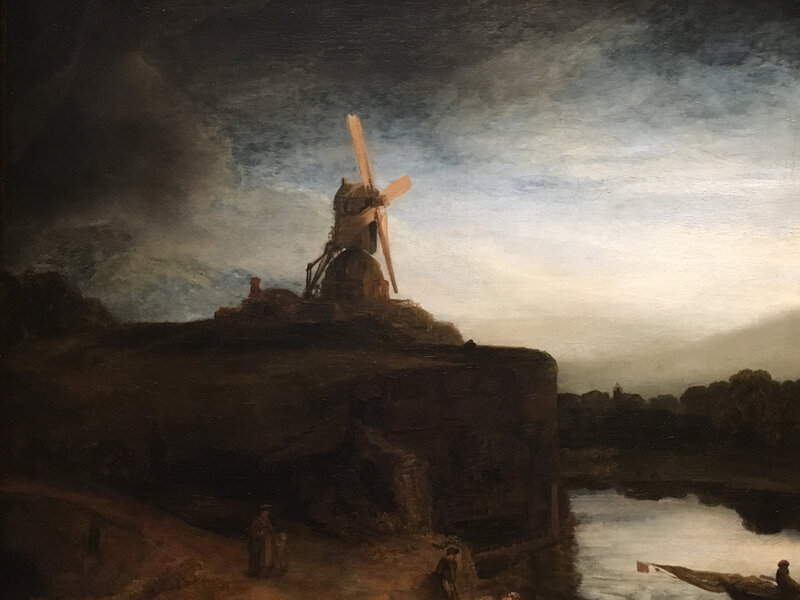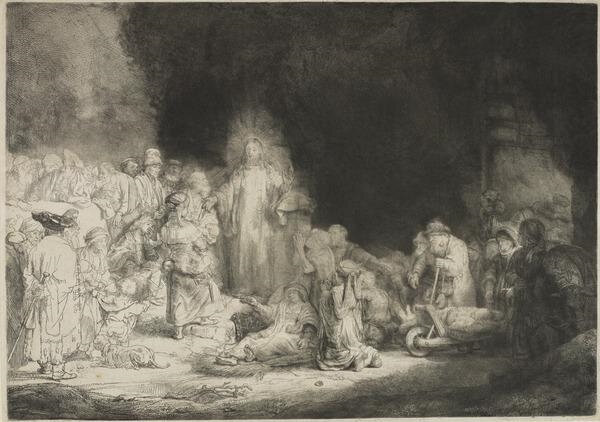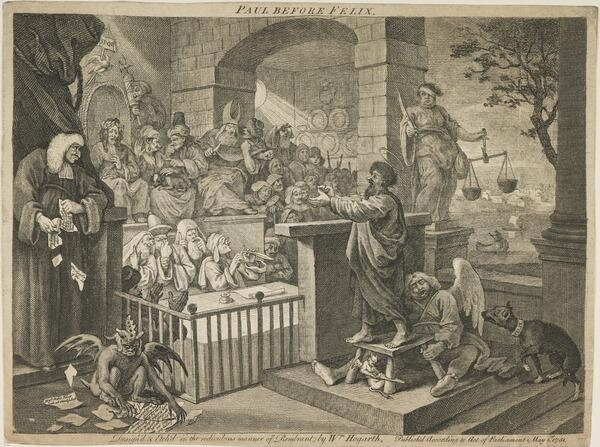Exhibition at Scottish National Gallery brings together key works by Rembrandt
Rembrandt van Rijn (1606-69), An Old Woman Reading, 1655. By kind permission of the Duke of Buccleuch & Queensberry KT KBE.
EDINBURGH.- Britain’s love affair with one of history’s greatest artists is being explored in the major Festival exhibition at the Scottish National Gallerythis summer. Rembrandt: Britain’s Discovery of the Master is the first exhibition to tell the exceptionally rich story of how Rembrandt’s work in Britain has enraptured and inspired collectors, artists and writers over the past 400 years. This major new exhibition, which is only being shown in Edinburgh, brings together key works by Rembrandt which remain in British collections, as well as treasures that have left the country. Some of the exhibits have never been on public display before, while others return to Britain for the first time in decades, some after even a century or more.
Speaking of the exhibition, Christopher Baker, Director, European and Scottish Art and Portraiture (National Galleries of Scotland), said: “This exhibition provides an extraordinary opportunity to study the staggering range of Rembrandt’s achievement and its profound impact on British taste and art. Featuring both major international loans and many less well-known rarities, it tells a riveting story. From the collectors of the artist’s own life time in the seventeenth century to today’s painters, Rembrandt has cast a spell on the British imagination. It’s a tale of scholarship and money, of privilege and popularity – and it’s all laid out exclusively in Edinburgh this Summer! For the first time, we’ll be offering a range of new ticket options, including off-peak prices, which we hope will allow as many people as possible to experience Rembrandt’s inspiring work.”
Rembrandt van Rijn (1606-69), Belshazzar’s Feast, c.1635, National Gallery, London. Bought with a contribution from The Art Fund, 1964.
The genius of Rembrandt (1606-69) is so universally admired, and his imagery so ubiquitous, that he has become a global brand like few other artists in history; yet no nation has demonstrated such a passionate, and sometimes eccentric, enthusiasm for Rembrandt’s (or indeed any artist’s) works. As a result, there is a wealth of paintings, drawings and prints by Rembrandt in British collections, and the number of his works that have been here at some point in their history is staggering, surpassing any other country apart from the Netherlands, where they originated.
The arrival of an early Self-portrait (c.1629), which was presented to Charles I before 1633, makes an impressive starting point for the exhibition (it was the first painting by Rembrandt to leave Holland), but did little to anticipate the level of adulation his work would inspire in the following century and which had become a kind of mania among British collectors around 1750. Rembrandt: Britain’s Discovery Of The Master brings together 15 major works in oil (and two further oils attributed to Rembrandt, and two more from his workshop), as well as an extensive selection of 15 outstanding drawings and more than 20 prints, including some of his most celebrated etchings, such as Christ Presented to the People (1655), The Three Trees (1643) and Portrait of Jan Six (1647).
Rembrandt van Rijn (1606-69), Girl at a Window, 1645. By permission of the Trustees if Dulwich Picture Gallery.
Great paintings such as Belshazzar’s Feast (c.1636-38) from the National Gallery London, and Girl at a Window (1645) from Dulwich Picture Gallery, are being shown alongside star works that are now overseas, such as The Mill (1645/8) from the National Gallery in Washington, which left Britain when it was sold to a US collector for the staggering sum of £100,000 in 1911.
The exhibition also reveals the profound impact of Rembrandt’s art on the British imagination, by exploring the wide range of native artists whose work has been inspired by the Dutch master right up to the present day.
Rembrandt van Rijn (1606-69), The Mill, 1645/1648. Oil on canvas, 87.6 x 105.6 cm. Collection: National Gallery of Art, Washington, USA. Widener Collection.
The son of a miller, Rembrandt was born and trained in Leiden, where he spent his early career. From 1631 he also worked in Amsterdam, mainly as a portrait painter, and he settled there permanently in 1634. Rembrandt married the same year and enjoyed a success as painter and printmaker, covering a wide range of subjects and receiving important private and public commissions. He oversaw a busy workshop with many pupils. Rembrandt nevertheless ran into financial difficulties – most likely due to an enormous mortgage on his house and substantial expenditure on his art collection – and was declared insolvent in 1656. After his large house and possessions had been sold, he continued to work in Amsterdam until his death. Contrary to what is widely believed, Rembrandt did not die in poverty, although he never again prospered as he had done at the height of his career.
Among the early arrivals in Britain were Rembrandt’s only portraits of ‘British’ sitters, Reverend Johannes Elison and his wife Maria Bockenolle (both 1634), which is on loan from the Museum of Fine Arts, Boston. Although they were painted in Amsterdam, the Boston portraits depict a Dutch couple who lived in Norwich, and the paintings were in Britain by 1680. Such expensive and ostentatious portraits are uncommon for clerics, and rare in Rembrandt’s work; they presumably reflect the status of the couple’s son, a successful merchant, who probably commissioned them. They are one of only three pairs of full-length portraits painted by Rembrandt, and have not been seen in the UK since 1929.
Rembrandt van Rijn (1606-69), Landscape with the Rest on the Flight into Egypt, 1647, © National Gallery of Ireland, Dublin.
A few years after the visit from the Norwich minister and his wife, Rembrandt was again busy exploring English subjects. A group of four drawings depicting English views has been much debated and is exhibited here together for the first time. The drawings, in which the locations – St Albans Cathedral, Windsor Castle and London with Old St Paul’s – are clearly identifiable, are of similar size and executed in pen, brown ink and wash. On stylistic grounds all four drawings must have been created in Rembrandt’s studio in about 1640, but controversies have centred around the questions of whether they are (all) by the hand of Rembrandt, and if they were drawn from prints or ‘from life’, which would infer, tantalisingly, that Rembrandt might have visited England.
From about 1720, the steady flow of major paintings by Rembrandt, such as the beautiful and tender Landscape with the Rest on the Flight into Egypt (1647) (which is on loan to this exhibition from the National Gallery in Dublin), grew into an enormous surge. By the 1770s Rembrandt mania was in full swing, pushing demand and prices to extraordinary levels. Even so, British collectors still succeeded in bringing prized pictures into the country, including An Old Woman Reading (1655), on loan here from the Buccleuch collection, and A Woman in Bed (Sarah) (1647), which is now in the National Galleries of Scotland.
Rembrandt van Rijn (1606-69), A Man in Armour, 1655, © Glasgow Museums Collection.
The publication in 1752 of a catalogue of Rembrandt’s etchings gave collectors a tool to identify different states or versions of the artist’s prints, as well as copies and forgeries. At the same time, it fuelled the craze for rarities such as corrected proof prints and impressions on exotic papers. To meet this desire for the uncommon, those who were fortunate enough to have access to Rembrandt’s original etching plates pulled new editions, sometimes creating collectors’ items that Rembrandt himself never produced; for example, impressions on satin or in red ink, such as Portrait of the Preacher Jan Cornelis Sylvius (1633) in the NGS collection. Reprints and copies catered to the huge demand for Rembrandt’s etchings in a competitive market. Captain William Baillie infamously acquired the worn plate of The Hundred Guilder Print, one of Rembrandt’s most famous etchings. He reworked it and in 1775 printed a limited edition, thereafter cutting the plate into four pieces and continuing to print from these mutilated fragments.
The impact of the massively enhanced exposure to Rembrandt’s imagery on artists in Britain was profound. The Dutch artist’s portraits and self-portraits in particular inspired British painters from William Hogarth, Thomas Hudson, Joseph Wright of Derby and Allan Ramsay to Sir Henry Raeburn and Sir Thomas Lawrence. Above all, it was Sir Joshua Reynolds who appreciated Rembrandt as an artist, writer and collector. His Rembrandt collection was one of the most distinguished in Britain, including prized paintings such as A Man in Armour (‘Achilles’) (1655), on loan here from Glasgow Museums. The strongest impact on Reynolds as a portraitist lasted from about 1745 to about 1770. His Portrait of Giuseppe Marchi (1753) (Royal Academy of Arts, London), and his Self-portrait from around the same time (Tate), both show strong chiaroscuro combined with warm colouring and – in the former – fancy oriental costume, all reminiscent of Rembrandt’s paintings.
Rembrandt van Rijn (1606-69), A Woman in Bed, c. 1645–46. Photo: Antonia Reeve. © National Galleries of Scotland.
In the early nineteenth century, British landscape painters also began to fall under Rembrandt’s spell. A major catalyst for this was the acquisition by a group of British collectors of The Mill (1645/48), which has been lent by the National Gallery of Art in Washington, and had been in the celebrated collection of the Duc d’Orléans. The Mill epitomises the Dutch artist’s influence on British landscape painting throughout the nineteenth century, starting with Turner, John Crome and John Constable.
The Victorian era also brought major shifts in the reception of Rembrandt’s art, thanks to the founding of public galleries, and the creation of exhibitions. The introduction of cheap reproduction techniques permitted an unprecedented popularisation. Rembrandt’s reputation also transformed, as a romantic image of him gained currency and he became, in the public imagination, a universally celebrated genius. Ultimately, Rembrandt himself became the subject in art and popular culture: with artists such as John Gilbert producing sumptuous paintings depicting imaginary scenes from his life.
Rembrandt van Rijn (1606-69), Reverend Johannes Elison, 1634. Oil on canvas, 174 x 124.5 cm. Collection: Museum of Fine Arts, Boston, USA. William K. Richardson Fund.
Throughout the early decades of the twentieth century, Rembrandt continued to represent the gold standard for etching revival artists, including the Scots James McBey, Sir David Young Cameron, Sir Muirhead Bone and William Strang. Their moody landscapes were much in fashion among specialist print collectors and fetched huge prices in Europe and America (some sold for higher prices than many original Rembrandts). This allowed printmakers like Cameron to become collectors of Rembrandt prints themselves (Cameron’s bequest of 55 outstanding etchings to the NGS transformed its holdings), but the Wall Street Crash of 1929 and the global financial collapse which ensued brought about a parallel collapse in the print market.
Rembrandt was also profoundly relevant for the artists of the ‘School of London’ group, which emerged in the 1950s. Among them Leon Kossoff and Frank Auerbach, who have been close friends for more than 60 years, have copied Rembrandt voraciously. Works by both artists based on Rembrandt’s celebrated A Woman Bathing in a Stream (1654) in the National Gallery collections, are being featured here, as will Rembrandt’s painting itself.
Rembrandt van Rijn (1606-69), The Three Crosses ('Christ Crucified between the Two Thieves'), 1660. © National Galleries of Scotland.
Many others have borrowed from Rembrandt in recent years. John Bellany, for example, did so in direct homages such as Danae: Homage to Rembrandt II (1991). Other, younger artists have viewed Rembrandt in a way that may seem cynical or disrespectful but which turns out to be the opposite. Glenn Brown has made painted, drawn and etched variants after Rembrandt since 1996, in works such as Unknown Pleasures (2016) and Half-Life (after Rembrandt) (2017), which offer a vibrant but deeply felt homage.
Clara Govier, Managing Director of People’s Postcode Lottery, said: “We are thrilled that, together with the Friends of the National Galleries of Scotland, players of People’s Postcode Lottery are supporting this beautiful exhibition. Like Rembrandt, PPL is a popular export from the Netherlands; our British players have now helped us to raise £310m for charities across the UK. We hope this once-in-a-lifetime show will be enjoyed by visitors from across the world, and we’re proud that the support of our Players has helped the National Galleries of Scotland to bring this ambitious project together".
Rembrandt van Rijn (1606-69), The Hundred Guilder Print (Bartsch no. 74 II/2), 1649. © National Galleries of Scotland.
William Hogarth, Paul Before Felix Burlesqued, 1751. © National Galleries of Scotland.
Joshua Reynolds, Portrait of Giuseppe Marchi, © Royal Academy of Arts, London.
Joshua Reynolds, Self-Portrait when Young, c. 1753–58, © Tate.
Frank Auerbach, Head of E.O.W. IV, 1961. Photo: Antonia Reeve. © Frank Auerbach, Courtesy Malboroug Fine Arts.
John Bellany, Homage to Rembrandt II, 1991. © The Bellany Estate

/https%3A%2F%2Fprofilepics.canalblog.com%2Fprofilepics%2F1%2F0%2F100183.jpg)
/https%3A%2F%2Fstorage.canalblog.com%2F03%2F02%2F119589%2F96711876_o.jpg)
/https%3A%2F%2Fstorage.canalblog.com%2F11%2F31%2F119589%2F94773502_o.jpg)
/https%3A%2F%2Fstorage.canalblog.com%2F20%2F83%2F119589%2F94772815_o.jpg)
/https%3A%2F%2Fstorage.canalblog.com%2F26%2F72%2F119589%2F75604929_o.jpg)
/https%3A%2F%2Fstorage.canalblog.com%2F59%2F60%2F119589%2F26458628_o.jpg)

















/http%3A%2F%2Fstorage.canalblog.com%2F34%2F13%2F119589%2F120701661_o.jpg)
/http%3A%2F%2Fstorage.canalblog.com%2F69%2F44%2F119589%2F95482366_o.jpg)
/http%3A%2F%2Fstorage.canalblog.com%2F32%2F83%2F119589%2F94314993_o.jpg)
/http%3A%2F%2Fstorage.canalblog.com%2F77%2F97%2F119589%2F92628339_o.jpg)